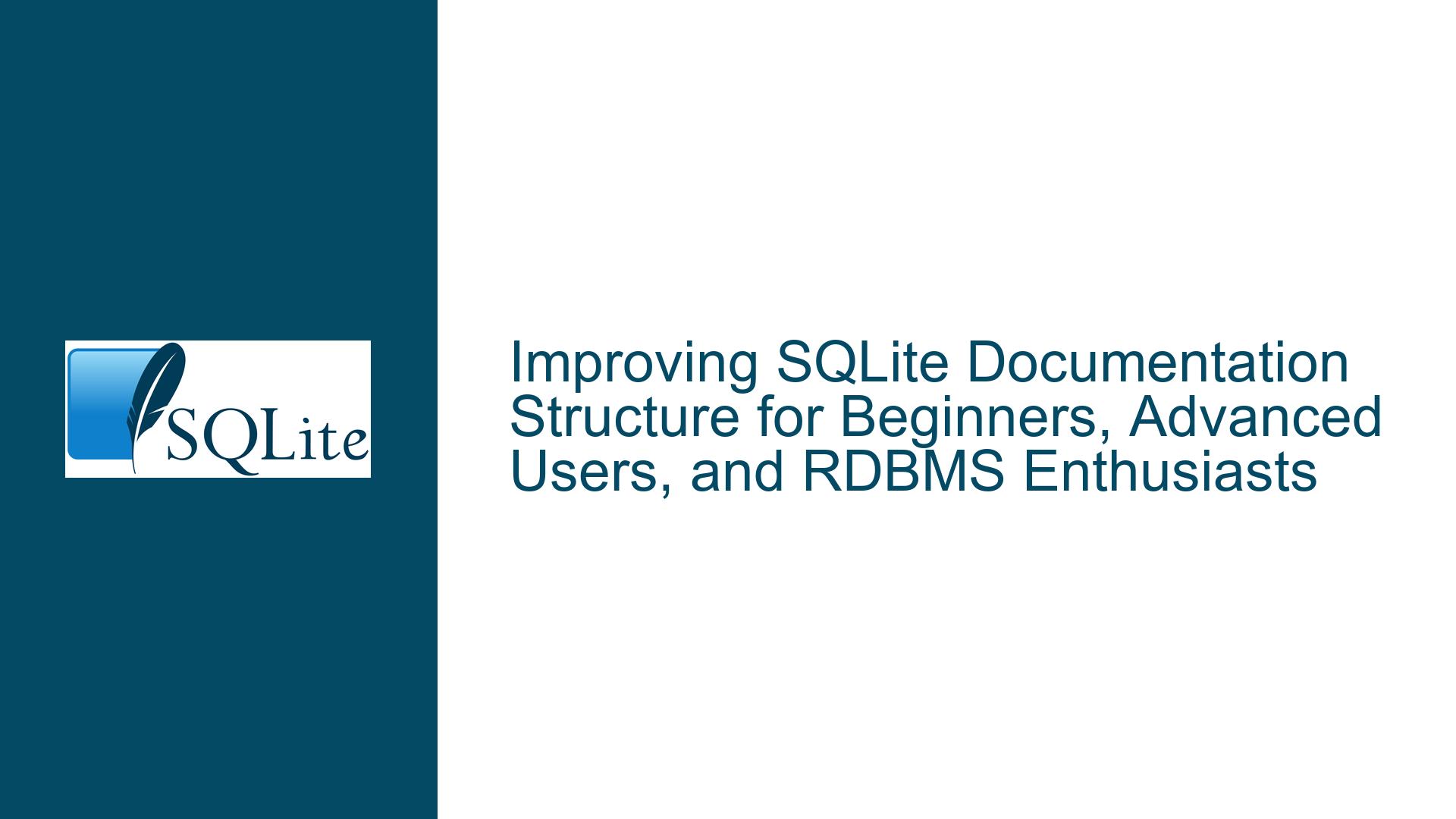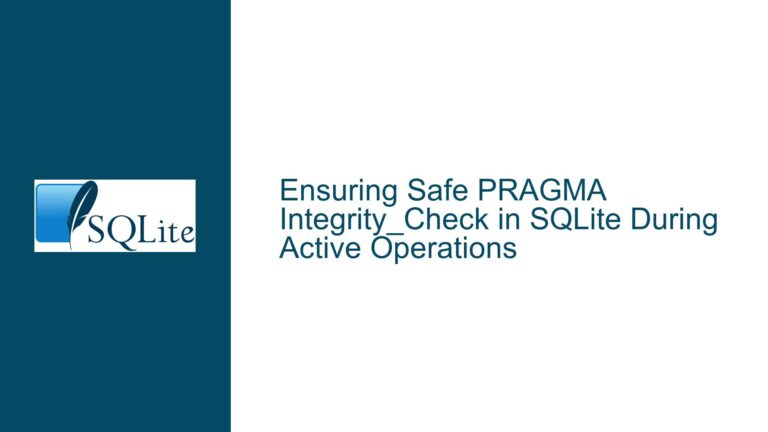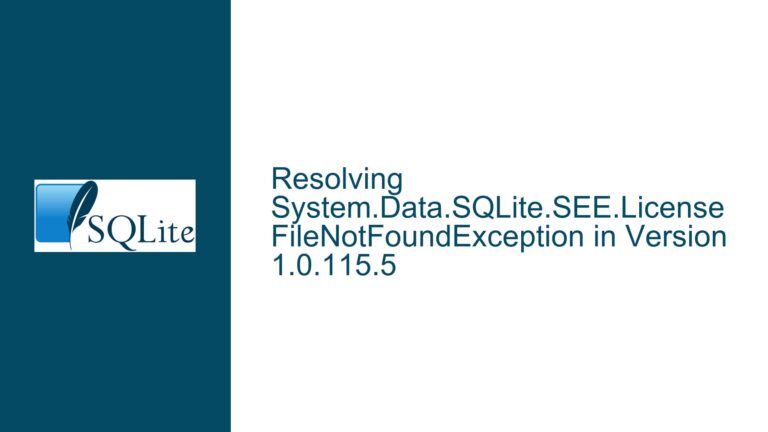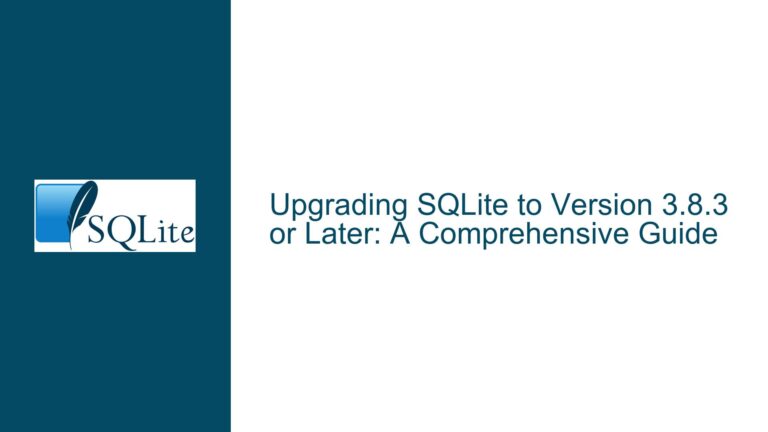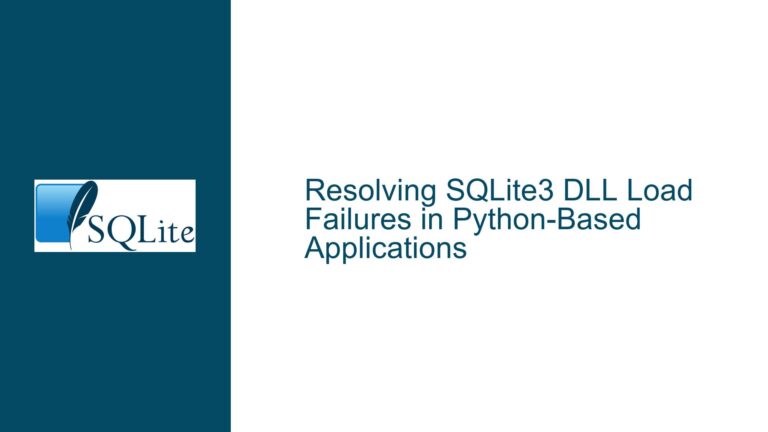Improving SQLite Documentation Structure for Beginners, Advanced Users, and RDBMS Enthusiasts
Issue Overview: The Need for a Tiered Documentation Structure in SQLite
The core issue revolves around the current structure of SQLite’s documentation, which is perceived as a hybrid between beginner-friendly content and advanced implementation details. This mixed approach can be overwhelming for users with varying levels of expertise. Beginners, who are just starting to run SQL queries on SQLite, may find themselves bogged down by advanced API details and implementation trivia that are irrelevant to their immediate needs. On the other hand, advanced users who are looking to integrate SQLite into their applications or delve into the intricacies of RDBMS design may find the documentation lacking in depth and specificity.
The current documentation does provide a "Getting Started" page, which serves as a brief introduction to SQLite. However, this page is not a comprehensive tutorial and primarily functions as a gateway to other resources. The API documentation, while detailed, is not segmented in a way that caters to different user levels. This lack of segmentation can lead to confusion, as users must sift through information that may not be pertinent to their current use case.
Moreover, the documentation does not clearly distinguish between tutorial content, advanced API usage, and RDBMS design principles. This lack of distinction can make it difficult for users to find the information they need without being overwhelmed by extraneous details. The suggestion to split the documentation into three distinct parts—tutorial, advanced, and RDBMS design—aims to address this issue by providing a more structured and user-friendly approach to learning and using SQLite.
Possible Causes: Why the Current Documentation Structure Falls Short
The current structure of SQLite’s documentation may be a result of several factors. First, the documentation is written with the assumption that users already have a foundational understanding of RDBMS concepts. This assumption can alienate beginners who are new to SQLite and relational databases in general. The documentation often jumps between high-level overviews and low-level implementation details, which can be disorienting for users who are still grappling with the basics.
Second, the API documentation, while comprehensive, is not always detailed enough to guide users through the integration process. The documentation provides the necessary inputs and outputs for each API function but may lack practical examples or step-by-step guides that demonstrate how to use these functions in real-world scenarios. This can make it challenging for users to translate the API documentation into actionable code.
Third, the documentation does not clearly separate tutorial content from advanced topics. This lack of separation can make it difficult for users to progress from beginner to advanced levels without getting lost in the details. The documentation also does not provide a dedicated section for RDBMS design principles, which would be valuable for users who are interested in understanding the inner workings of SQLite.
Finally, the documentation may suffer from a lack of resources dedicated to creating and maintaining a more structured and user-friendly format. Writing high-quality tutorials and advanced guides requires significant time and effort, and the SQLite team may not have the resources to allocate to this task. Additionally, the current documentation may be influenced by the need to balance the interests of different user groups, which can result in a compromise that does not fully satisfy any one group.
Troubleshooting Steps, Solutions & Fixes: Implementing a Tiered Documentation Structure
To address the issues outlined above, SQLite’s documentation should be restructured into three distinct tiers: tutorial, advanced, and RDBMS design. This tiered approach would provide a more organized and user-friendly experience for all levels of users.
Tutorial Tier:
The tutorial tier should be designed for beginners who are new to SQLite and relational databases. This tier should include step-by-step guides that walk users through the basics of SQLite, from installation to running simple SQL queries. The tutorial should also cover fundamental concepts such as database creation, table management, and basic CRUD operations. Practical examples and exercises should be included to help users apply what they have learned.
The tutorial tier should avoid delving into advanced topics or implementation details. Instead, it should focus on providing a solid foundation that prepares users for more advanced topics. Links to the advanced tier should be included for users who are ready to move on to more complex topics.
Advanced Tier:
The advanced tier should cater to users who are looking to integrate SQLite into their applications or delve into more complex SQL queries. This tier should provide detailed API documentation, including practical examples and use cases that demonstrate how to use the API in real-world scenarios. The advanced tier should also cover topics such as transaction management, indexing, and performance optimization.
The advanced tier should be structured in a way that allows users to easily find the information they need. Each API function should be documented with clear explanations of its purpose, inputs, outputs, and potential pitfalls. Code snippets and examples should be provided to illustrate how each function can be used in practice.
RDBMS Design Tier:
The RDBMS design tier should be aimed at users who are interested in understanding the inner workings of SQLite. This tier should provide detailed explanations of SQLite’s database file format, virtual database engine, and other implementation details. The RDBMS design tier should also cover topics such as concurrency control, storage engines, and query optimization.
The RDBMS design tier should be written in a way that is accessible to users with a strong technical background. It should provide in-depth explanations of the design principles and algorithms that underpin SQLite, along with references to the source code for users who want to explore further.
Implementation Considerations:
Implementing a tiered documentation structure will require careful planning and execution. The SQLite team should consider the following steps:
Content Segmentation: The first step is to segment the existing documentation into the three tiers. This will involve identifying which content belongs in each tier and reorganizing the documentation accordingly. Content that does not fit neatly into one of the tiers should be reviewed and either revised or removed.
Content Creation: Once the content has been segmented, the next step is to create new content for each tier. This will involve writing new tutorials, expanding the API documentation, and adding detailed explanations of RDBMS design principles. The SQLite team may need to allocate additional resources to this task or seek contributions from the community.
User Feedback: After the new documentation structure has been implemented, the SQLite team should solicit feedback from users to identify any areas that need improvement. This feedback can be used to refine the documentation and ensure that it meets the needs of all user levels.
Ongoing Maintenance: The documentation should be regularly updated to reflect changes in SQLite and to address any issues that arise. The SQLite team should establish a process for reviewing and updating the documentation on a regular basis.
By implementing a tiered documentation structure, SQLite can provide a more organized and user-friendly experience for all levels of users. This approach will help beginners get up to speed quickly, provide advanced users with the detailed information they need, and offer RDBMS enthusiasts a deeper understanding of SQLite’s design and implementation.
